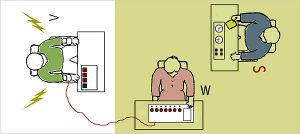Asch and Milgram Experiments : Social Psychology

THE ASCH EXPERIMENT
The Asch Experiment is a study conducted by the American Social Psychologist Solomon Asch, published in 1953, also known as the Asch Line Conformity Study. In this experiment, it has been tried to measure the importance of people around a person in the decision-making process. For this experiment, while the participants sit around a table, the real subject sits at the end of the table. In fact, the other participants sitting at the table are actors hired by the researchers. However, the real subject did not know that he was actually the only subject in this experiment.
 When the experiment begins, participants are shown a total of 4 lines, one on the left and three on the right. And they are asked which line is the equal length of the line on the left side from the right side. In the first two rounds, the actors give the correct answer, and when it comes to our actual subject, he also gives the correct answer. After the third round, the actors confidently start giving the wrong answers. And although some subjects did not comply with the group at first and had the correct answer, it was observed that their real expressions changed and they felt obliged to comply with the group.
When the experiment begins, participants are shown a total of 4 lines, one on the left and three on the right. And they are asked which line is the equal length of the line on the left side from the right side. In the first two rounds, the actors give the correct answer, and when it comes to our actual subject, he also gives the correct answer. After the third round, the actors confidently start giving the wrong answers. And although some subjects did not comply with the group at first and had the correct answer, it was observed that their real expressions changed and they felt obliged to comply with the group.
The reason why the subjects felt the need to adapt was also criticized by the researchers. Some researchers argue that people do this not because of the desire to adapt to the group, but because they focus on avoiding any conflict.
The experiment lasted 12 stages in total, and nearly 75% of the participants who participated in the study chose to conform to the majority at least one part of the experiment. With this result, it has been observed that people do not like to be the only protrusion in a certain social environment. It has also been shown to what extent people’s behaviors are affected by the pressure to adapt to their environment.
(credit: https://tr.wikipedia.org/wiki/Asch_deneyi)
MILGRAM SCHOCK EXPERIMENT
This experiment was conducted by psychologist Stanley Milgram in 1961. It is intended to understand people’s willingness and tendency to submit to authority. There are 3 roles in this experiment: Student, teacher, and authority. The student is in the role of the actor because she has been prescribed and will act accordingly. The teacher is the person who is the subject, it is aimed to observe their behavior. And the authority is the representation of the researcher. Before the experiment, it is treated as if the roles are randomly allocated, but in fact, the subject will always be the teacher because the actor is prepared for the student role. The subject is given a shock before the experiment and it is ensured that she understands the pain her student will feel during the experiment.

During the experiment, the teacher is asked to read a word from the list in his hand. Then he will count 4 options and ask the student to find the option that matches the word. If the student chooses the wrong option, he will be given an electric shock. With every wrong answer, the electric shock increases. Moreover, the teacher (subject) thinks that the student is actually receiving an electric shock, but the student (actor) is just pretending to be in pain. If the subject cannot stand the painful yelling of the student and wants to stop, the authority will insist 4 times but will stop the experiment on the 5th time.
(credit: https://www.nytimes.com/2008/07/01/health/research/01mind.html )
After the experiment started, teachers (subjects) usually hesitated before each amplifying the electric shock. But the interesting thing is that when they thought that the money they would get from the experiment and that the authority ordered it, they decided to continue the experiment. It is observed that the pressure of authority has overcome these subjects’ pity.
In this case, it was observed whether the subject would obey the orders given by the authority despite the pain of the student. As a result, 65% of the subjects submitted the highest dose of electric shock to their student, submitting to the authority. As a result of this experiment, Milgram found that the individual does not see himself/herself responsible for his/her behavior while doing what someone else wants.
RESOURCES:
- Ciccarelli, S. K., & White, J. N. (2018), Psychology (Fifth Edition). Pearson.
- https://www.youtube.com/watch?v=NyDDyT1lDhA
- https://www.verywellmind.com/the-asch-conformity-experiments-2794996
- https://www.khanacademy.org/ela/cc-9th-reading-vocab/x73a76fccbaf2a246:cc-9th-social-psychology/x73a76fccbaf2a246:reading-for-understanding-informational-text/v/milgram-experiment-on-obedience







